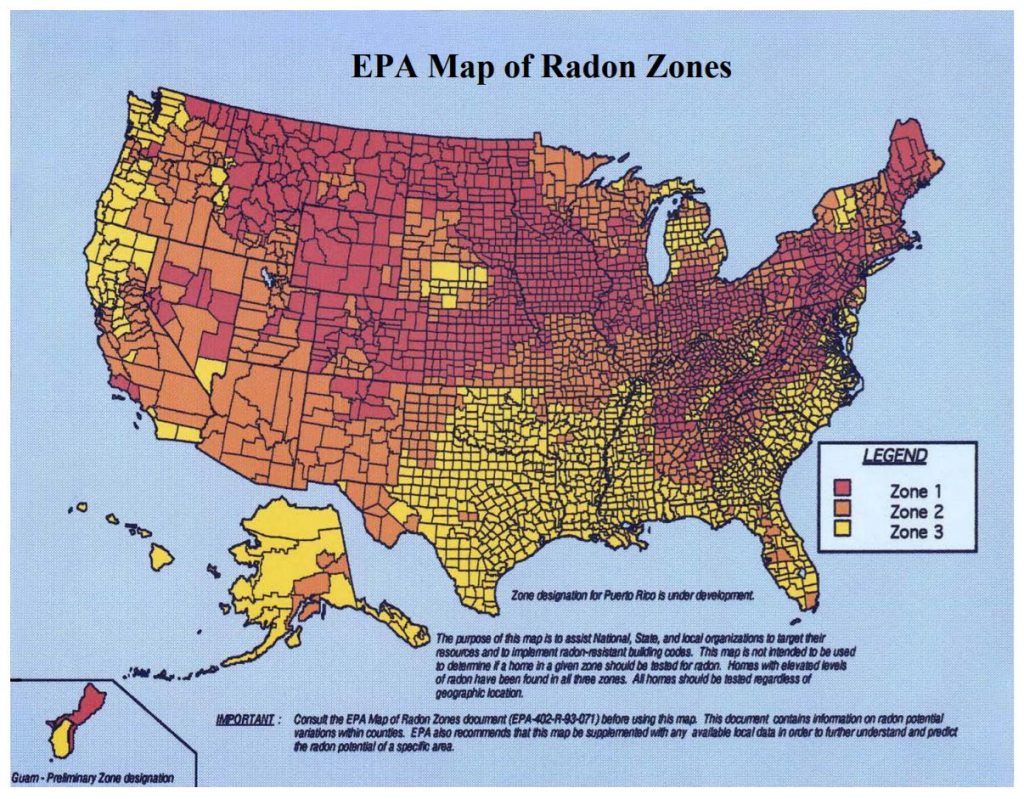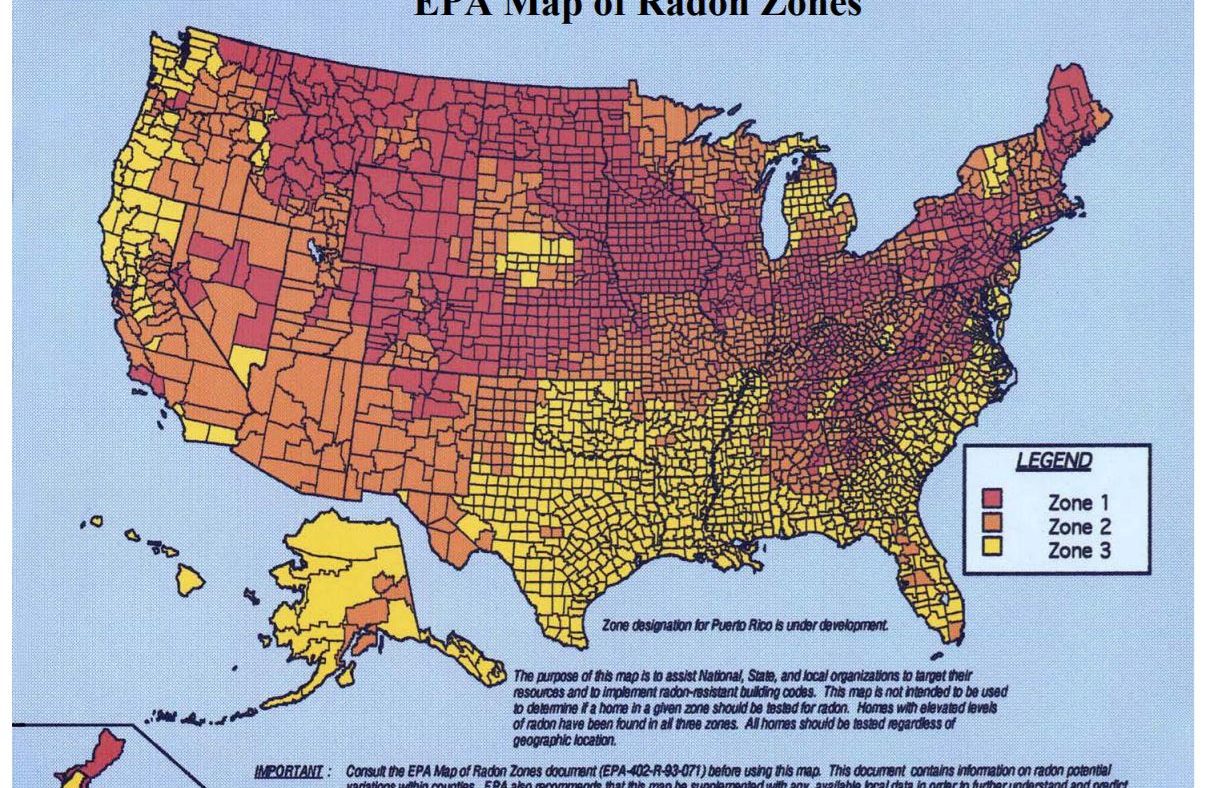What is Radon?
It is difficult to think about something that you cannot see, smell, or taste; but in the case of radon, out of sight should not mean out of mind. Radon is a naturally occurring radioactive gas, which results from the decay of uranium. When you think about a healthy lifestyle, the terms radioactive, uranium, and gas probably don’t come to mind, and they shouldn’t. Radon and its decay products are the second leading cause of lung cancer in the United States behind tobacco smoke. According to the United States Environmental Protection Agency (USEPA), upwards of 21,000 Americans die each year from radon induced cancers. As such, the EPA has established a recommended radon action (mitigation) level of 4.0 picoCurie’s/Liter (pC/L) which, to put into perspective, is the equivalent of 200 chest x-rays. To scale it down, 1.0 pC/L is equal to smoking 2.5 cigarettes a day. So, who is at risk of radon exposure? Everyone. The EPA estimates that elevated radon concentrations (4.0 pC/L or greater) are present in 1 in 15 homes across the country.

Image courtesy of the USEPA (Radon concentrations are highly variable and have been tested at greater than 100 pC/L in low probability areas. Homes in these areas should still be tested.)
How Are We Exposed to Radon?
The primary source of radon exposure is through soil gas. Call it what you will, claustrophobia or diffusion, as uranium in rocks decay underground, the radon gas emitted rises to less crowded, less concentrated areas. Similar to the way water follows the path of least resistance downhill, radon gas travels through cracks in rocks and permeable soil up to the surface of the earth. There is a natural level of radon in the ambient air, estimated at about 0.4 pC/L, but what we are more concerned about is concentrated levels of radon indoors.
How does it get in? Radon enters buildings through cracks in the foundations and/or basement walls, unsealed joints, and utility chases. What doesn’t help, is that pressure differentials from temperature, weather, and building mechanical systems (ventilation and exhaust), can help draw in more radon gas. Once radon has entered the building, the gas and decay products can be inhaled, causing damage to lung tissue.
Radon is Not Limited to Lower Levels
As we are more interested in radon concentrations indoors, we are also more interested in radon concentrations in places we spend most of our time, i.e. homes, schools, and work. Surprisingly, radon testing in association with real estate transactions has only been around since the early 1990s. While guidelines exist for schools and other commercial buildings, most standards and guidelines for radon exposure focus heavily on radon in the home. The guidelines place heavy emphasis on testing basements, ground-floors, and lowest occupiable/livable levels. VERTEX and other radon professionals have learned to never rule out the upper floors. VERTEX conducts radon testing in many multi-story and high-rise apartment buildings and has found that radon transport can occur quite readily through stairwells and elevator shafts, transporting radon to upper levels. This is further complicated if the property is serviced by a private well which may introduce radon in water through sinks and showers throughout the building.
Radon in Building Materials
Most high-rise buildings are constructed with concrete, and everything that makes up concrete comes from the ground. Radon has been found to emanate from some concrete, granite, and other stone finishes, but the concentrations are usually low or diminished by ventilation.
What About Buildings without a lot of Natural Ventilation?
In places like Florida with hurricane driven building codes or in structures built with energy savings in mind, the result has been stronger, tighter, concrete buildings, where indoor air doesn’t escape as easy and outdoor air is only brought in on purpose. As tighter, more energy efficient homes are being constructed, they rely on state of the art ventilation (HVAC) systems to provide a comfortable living space with the least amount of environmental impact. These tighter homes act as a collection point for radon, which can build up to unsafe levels. With the mounting evidence of elevated radon in upper floors, testing these areas cannot be ignored. Often times, adjustments or additions to the HVAC system can result in improvements.
How Can VERTEX Help?
Radon testing is fairly easy and relatively inexpensive. VERTEX has a large team of highly trained radon professionals including personnel who are certified radon measurement and mitigation providers by the American Association of Radon Scientists and Technologists National Radon Proficiency Program (AARST-NRPP), as well as certain State radon programs.
As a full-scale engineering firm, VERTEX is more than just your standard radon shop. We are able to combine our extensive experience in both the construction and the property development industry to design and develop radon measurement and mitigation programs tailored to your specific project. Our experience and resources allow us to mitigate projects that may be beyond the scope of local residential radon professionals. From testing to mitigation, VERTEX can help every step of the way.
To learn more about VERTEX’s Environmental Consulting services or to speak with an Environmental Expert, call 888.298.5162 or submit an inquiry.




